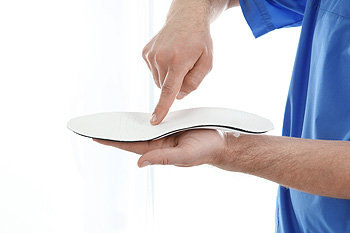 If you are experiencing foot pain as a result of disease or an arthritic condition, wearing custom-made orthotics may produce positive results. These are known as removable shoe inserts and may be helpful in providing moderate relief. The proper type and size of orthotics is determined by having an impression of the foot taken with a plaster cast mold, and this may allow for any necessary adjustments to be made. There are several foot conditions that may benefit from wearing orthotics, which may include plantar fasciitis, rheumatoid arthritis, or bunions. If you have uncomfortable pain in your feet, it is suggested to speak to a podiatrist who can discuss the benefits of wearing custom-made orthotics, and who is able to determine if this is right for you.
If you are experiencing foot pain as a result of disease or an arthritic condition, wearing custom-made orthotics may produce positive results. These are known as removable shoe inserts and may be helpful in providing moderate relief. The proper type and size of orthotics is determined by having an impression of the foot taken with a plaster cast mold, and this may allow for any necessary adjustments to be made. There are several foot conditions that may benefit from wearing orthotics, which may include plantar fasciitis, rheumatoid arthritis, or bunions. If you have uncomfortable pain in your feet, it is suggested to speak to a podiatrist who can discuss the benefits of wearing custom-made orthotics, and who is able to determine if this is right for you.
If you are having discomfort in your feet and would like to try orthotics, contact one of our podiatrists from Lovely Foot Associates, PC. Our doctors can provide the care you need to keep you pain-free and on your feet.
What Are Orthotics?
Orthotics are inserts you can place into your shoes to help with a variety of foot problems such as flat feet or foot pain. Orthotics provide relief and comfort for minor foot and heel pain but can’t correct serious biomechanical problems in your feet.
Over-the-Counter Inserts
Orthotics come in a wide variety of over-the-counter inserts that are used to treat foot pain, heel pain, and minor problems. For example, arch supports can be inserted into your shoes to help correct overarched or flat feet, while gel insoles are often used because they provide comfort and relief from foot and heel pain by alleviating pressure.
Prescription Orthotics
If over-the-counter inserts don’t work for you or if you have a more severe foot concern, it is possible to have your podiatrist prescribe custom orthotics. These high-quality inserts are designed to treat problems such as abnormal motion, plantar fasciitis, and severe forms of heel pain. They can even be used to help patients suffering from diabetes by treating foot ulcers and painful calluses and are usually molded to your feet individually, which allows them to provide full support and comfort.
If you are experiencing minor to severe foot or heel pain, it’s recommended to speak with your podiatrist about the possibilities of using orthotics. A podiatrist can determine which type of orthotic is right for you and allow you to take the first steps towards being pain-free.
If you have any questions please contact our office located in Johnstown, PA . We offer the newest diagnostic and treatment technologies for all your foot and ankle needs.
Read more about Ankle Foot Orthotics for Athletes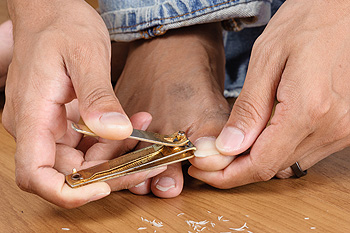 The importance of implementing daily foot care may be crucial to the overall health of the body. It may be easy to overlook the simple care the feet desire when poorly fitting shoes are worn, in addition to the feet possibly being enveloped in tight and sweaty socks for most of the day. The feet endure the weight from the entire body and may become injured as a result of the impact from daily walking. Research has shown the feet will generally feel better when they are washed and dried daily, followed by utilizing a good moisturizer, especially in the winter months. Shoes that are chosen should feel comfortable when they are initially tried on and shoes that do not have adequate arch support should be avoided. Additionally, there are conditions that may affect your feet, including diabetes, pregnancy, and the aging process and it is beneficial to consult with a podiatrist to discuss the changes in foot structure that may occur.
The importance of implementing daily foot care may be crucial to the overall health of the body. It may be easy to overlook the simple care the feet desire when poorly fitting shoes are worn, in addition to the feet possibly being enveloped in tight and sweaty socks for most of the day. The feet endure the weight from the entire body and may become injured as a result of the impact from daily walking. Research has shown the feet will generally feel better when they are washed and dried daily, followed by utilizing a good moisturizer, especially in the winter months. Shoes that are chosen should feel comfortable when they are initially tried on and shoes that do not have adequate arch support should be avoided. Additionally, there are conditions that may affect your feet, including diabetes, pregnancy, and the aging process and it is beneficial to consult with a podiatrist to discuss the changes in foot structure that may occur.
Everyday foot care is very important to prevent infection and other foot ailments. If you need your feet checked, contact one of our podiatrists from Lovely Foot Associates, PC. Our doctors can provide the care you need to keep you pain-free and on your feet.
Everyday Foot Care
Often, people take care of their bodies, face and hair more so than they do for their feet. But the feet are a very important aspect of our bodies, and one that we should pay more attention to. Without our feet, we would not be able to perform most daily tasks.
It is best to check your feet regularly to make sure there are no new bruises or cuts that you may not have noticed before. For dry feet, moisturizer can easily be a remedy and can be applied as often as necessary to the affected areas. Wearing shoes that fit well can also help you maintain good foot health, as well as making it easier to walk and do daily activities without the stress or pain of ill-fitting shoes, high heels, or even flip flops. Wearing clean socks with closed shoes is important to ensure that sweat and bacteria do not accumulate within the shoe. Clean socks help to prevent Athlete’s foot, fungi problems, bad odors, and can absorb sweat.
If you have any questions please feel free to contact our office located in Johnstown, PA . We offer the newest diagnostic and treatment technologies for all your foot and ankle needs.
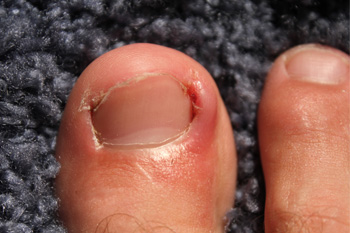 There are several ways to develop the painful and uncomfortable condition known as an ingrown toenail. It occurs when the toenail grows into the skin on the side of the nail and may occur due to several different reasons. These may include trimming the toenails incorrectly, wearing shoes and socks that are too tight, or possibly enduring an injury to the toe. There may be options, which may provide moderate relief, including soaking the toe in warm water, wearing the correct footwear that has adequate room for the toes to move about in, or taking antibiotics for an ingrown toenail that becomes infected. Research has shown there are three stages that take place when this condition occurs. The first phase consists of swelling around the side of the nail. Possible drainage and increased pain may be present in phase two, and phase three will typically consist of chronic and recurring infections. If you have developed an ingrown toenail, it is advised to consult with a podiatrist as quickly as possible to discuss the best treatment for you.
There are several ways to develop the painful and uncomfortable condition known as an ingrown toenail. It occurs when the toenail grows into the skin on the side of the nail and may occur due to several different reasons. These may include trimming the toenails incorrectly, wearing shoes and socks that are too tight, or possibly enduring an injury to the toe. There may be options, which may provide moderate relief, including soaking the toe in warm water, wearing the correct footwear that has adequate room for the toes to move about in, or taking antibiotics for an ingrown toenail that becomes infected. Research has shown there are three stages that take place when this condition occurs. The first phase consists of swelling around the side of the nail. Possible drainage and increased pain may be present in phase two, and phase three will typically consist of chronic and recurring infections. If you have developed an ingrown toenail, it is advised to consult with a podiatrist as quickly as possible to discuss the best treatment for you.
Ingrown toenails may initially present themselves as a minor discomfort, but they may progress into an infection in the skin without proper treatment. For more information about ingrown toenails, contact one of our podiatrists of Lovely Foot Associates, PC. Our doctors can provide the care you need to keep you pain-free and on your feet.
Ingrown Toenails
Ingrown toenails are caused when the corner or side of a toenail grows into the soft flesh surrounding it. They often result in redness, swelling, pain, and in some cases, infection. This condition typically affects the big toe and may recur if it is not treated properly.
Causes
You are more likely to develop an ingrown toenail if you are obese, have diabetes, arthritis, or have any fungal infection in your nails. Additionally, people who have foot or toe deformities are at a higher risk of developing an ingrown toenail.
Symptoms
Some symptoms of ingrown toenails are redness, swelling, and pain. In rare cases, there may be a yellowish drainage coming from the nail.
Treatment
Ignoring an ingrown toenail can have serious complications. Infections of the nail border can progress to a deeper soft-tissue infection, which can then turn into a bone infection. You should always speak with your podiatrist if you suspect you have an ingrown toenail, especially if you have diabetes or poor circulation.
If you have any questions, please feel free to contact our office located in Johnstown, PA . We offer the newest diagnostic and treatment technologies for all your foot care needs.
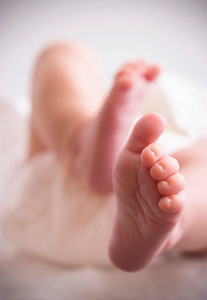 One of the main differences between children and adult feet is the flexibility of the foot. This may be a result of the lack of bones in a child’s foot, which may cause the feet to be soft and supple. Toddlers will generally begin to walk at approximately twelve months of age, and research has shown it is beneficial to encourage the child to walk barefoot indoors, which may aid in developing the strength of the toes. This will enable the child to grasp the floor, which enhances overall balance and the walking process. Potential skin conditions may be avoided when fresh cotton socks are worn daily, in addition to airing the shoes out overnight. The importance of measuring the child’s feet is crucial in determining the correct shoe size, and this should ideally be implemented every three months prior to three years of age. Most babies are born with flat feet, and the arch will typically develop by the age of seven years old. If you notice any abnormalities about your children’s feet or how they walk, it is strongly advised to speak to a podiatrist who can properly guide you.
One of the main differences between children and adult feet is the flexibility of the foot. This may be a result of the lack of bones in a child’s foot, which may cause the feet to be soft and supple. Toddlers will generally begin to walk at approximately twelve months of age, and research has shown it is beneficial to encourage the child to walk barefoot indoors, which may aid in developing the strength of the toes. This will enable the child to grasp the floor, which enhances overall balance and the walking process. Potential skin conditions may be avoided when fresh cotton socks are worn daily, in addition to airing the shoes out overnight. The importance of measuring the child’s feet is crucial in determining the correct shoe size, and this should ideally be implemented every three months prior to three years of age. Most babies are born with flat feet, and the arch will typically develop by the age of seven years old. If you notice any abnormalities about your children’s feet or how they walk, it is strongly advised to speak to a podiatrist who can properly guide you.
Making sure that your children maintain good foot health is very important as they grow. If you have any questions, contact one of our podiatrists of Lovely Foot Associates, PC. Our doctors can provide the care you need to keep you pain-free and on your feet.
Keeping Children's Feet Healthy
Having healthy feet during childhood can help prevent medical problems later in life, namely in the back and legs. As children grow, their feet require different types of care. Here are some things to consider...
Although babies do not walk yet, it is still very important to take care of their feet.
Avoid putting tight shoes or socks on his or her feet.
Allow the baby to stretch and kick his or her feet to feel comfortable.
As a toddler, kids are now on the move and begin to develop differently. At this age, toddlers are getting a feel for walking, so don’t be alarmed if your toddler is unsteady or ‘walks funny’.
As your child gets older, it is important to teach them how to take care of their feet.
Show them proper hygiene to prevent infections such as fungus.
Be watchful for any pain or injury.
Have all injuries checked by a doctor as soon as possible.
Comfortable, protective shoes should always be worn, especially at play.
If you have any questions please feel free to contact our office located in Johnstown, PA . We offer the newest diagnostic and treatment technologies for all your foot and ankle needs.
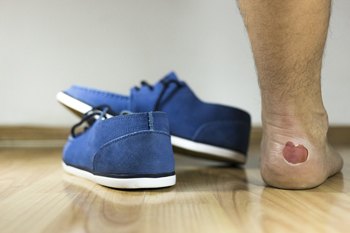 One of the ways to have a more enjoyable travel experience is to include comfortable shoes in your suitcase. If you are planning on spending most of the day walking or exploring, it’s important to choose shoes that fit properly. Many patients may experience the uncomfortable condition that is known as blisters, and this may hinder any walking plans you may have. When purchasing new shoes, there may be a breaking-in period that is needed, and this may be beneficial by doing this before the trip begins. Many people have worn their new shoes with wool socks, and this may be helpful in softening the interior of the shoe. If a painful blister should occur, it may be advantageous to bring a medical kit, which may include different sizes and types of bandages, and an additional pair of socks. It is advised to contact a podiatrist if you would like additional information on the prevention or treatment of blisters.
One of the ways to have a more enjoyable travel experience is to include comfortable shoes in your suitcase. If you are planning on spending most of the day walking or exploring, it’s important to choose shoes that fit properly. Many patients may experience the uncomfortable condition that is known as blisters, and this may hinder any walking plans you may have. When purchasing new shoes, there may be a breaking-in period that is needed, and this may be beneficial by doing this before the trip begins. Many people have worn their new shoes with wool socks, and this may be helpful in softening the interior of the shoe. If a painful blister should occur, it may be advantageous to bring a medical kit, which may include different sizes and types of bandages, and an additional pair of socks. It is advised to contact a podiatrist if you would like additional information on the prevention or treatment of blisters.
Blisters are prone to making everyday activities extremely uncomfortable. If your feet are hurting, contact one of our podiatrists of Lovely Foot Associates, PC. Our doctors can provide the care you need to keep you pain-free and on your feet.
Foot Blisters
Foot blisters develop as a result of constantly wearing tight or ill-fitting footwear. This happens due to the constant rubbing from the shoe, which can often lead to pain.
What Are Foot Blisters?
A foot blister is a small fluid-filled pocket that forms on the upper-most layer of the skin. Blisters are filled with clear fluid and can lead to blood drainage or pus if the area becomes infected.
How Do Blisters Form?
Blisters on the feet are often the result of constant friction of skin and material, usually by shoe rubbing. Walking in sandals, boots, or shoes that don’t fit properly for long periods of time can result in a blister. Having consistent foot moisture and humidity can easily lead to blister formation.
Prevention & Treatment
It is important to properly care for the affected area in order to prevent infection and ease the pain. Do not lance the blister and use a Band-Aid to provide pain relief. Also, be sure to keep your feet dry and wear proper fitting shoes. If you see blood or pus in a blister, seek assistance from a podiatrist.
If you have any questions, please feel free to contact our office located in Johnstown, PA . We offer the newest diagnostic and treatment technologies for all your foot care needs.
Read more about Blisters on the Feet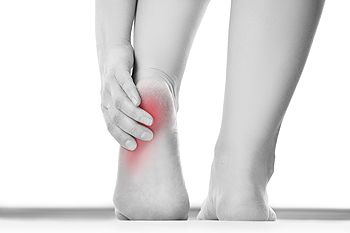 If you have a heel spur, you are most likely familiar with the pain and discomfort this condition may cause. The small, bony protrusion that forms on the heel may be a result of repetitive stress the heel endures, possibly originating from frequent running or jumping. Additionally, if the incorrect shoes are worn, or an abnormal walking pattern exists, a heel spur may begin to develop. Some patients may notice pain in the heel and surrounding area while walking, and it may be quite uncomfortable in the morning when the first steps are taken. There may be measures that can be taken, which may possibly prevent heel spurs from forming. These may include wearing shoes that properly support your feet, performing gentle foot stretches before physical activity begins, and maintaining a healthy weight, which may lessen the amount of pressure the heel may endure. If you have heel pain, it is suggested to speak with a podiatrist who can determine if you have a heel spur and can advise on proper treatment techniques.
If you have a heel spur, you are most likely familiar with the pain and discomfort this condition may cause. The small, bony protrusion that forms on the heel may be a result of repetitive stress the heel endures, possibly originating from frequent running or jumping. Additionally, if the incorrect shoes are worn, or an abnormal walking pattern exists, a heel spur may begin to develop. Some patients may notice pain in the heel and surrounding area while walking, and it may be quite uncomfortable in the morning when the first steps are taken. There may be measures that can be taken, which may possibly prevent heel spurs from forming. These may include wearing shoes that properly support your feet, performing gentle foot stretches before physical activity begins, and maintaining a healthy weight, which may lessen the amount of pressure the heel may endure. If you have heel pain, it is suggested to speak with a podiatrist who can determine if you have a heel spur and can advise on proper treatment techniques.
Heel spurs can be incredibly painful and sometimes may make you unable to participate in physical activities. To get medical care for your heel spurs, contact one of our podiatrists from Lovely Foot Associates, PC. Our doctors will do everything possible to treat your condition.
Heels Spurs
Heel spurs are formed by calcium deposits on the back of the foot where the heel is. This can also be caused by small fragments of bone breaking off one section of the foot, attaching onto the back of the foot. Heel spurs can also be bone growth on the back of the foot and may grow in the direction of the arch of the foot.
Older individuals usually suffer from heel spurs and pain sometimes intensifies with age. One of the main condition's spurs are related to is plantar fasciitis.
Pain
The pain associated with spurs is often because of weight placed on the feet. When someone is walking, their entire weight is concentrated on the feet. Bone spurs then have the tendency to affect other bones and tissues around the foot. As the pain continues, the feet will become tender and sensitive over time.
Treatments
There are many ways to treat heel spurs. If one is suffering from heel spurs in conjunction with pain, there are several methods for healing. Medication, surgery, and herbal care are some options.
If you have any questions feel free to contact our office located in Johnstown, PA . We offer the latest in diagnostic and treatment technology to meet your needs.
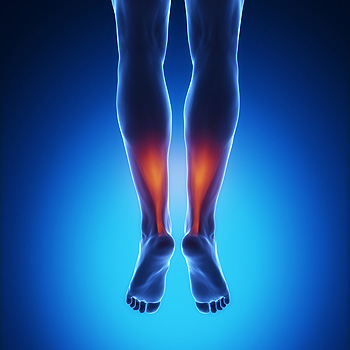 The Achilles tendon is the tissue that connects calf muscles to the heel bone, and overuse of this tendon can result in Achilles tendinitis. This tendon is used while walking, running, jumping, and performing most other actions associated with foot movement. High-intensity sports are often the cause of this condition. It is common in middle-aged adults that run, play tennis, or play basketball. The pain associated with Achilles tendinitis usually starts with a minor ache above the heel after a sports activity. This pain can escalate and become episodic in relation to increased physical movement. Tenderness and stiffness may also be felt the next morning but will fade throughout the day. This pain is a result of straining the Achilles tendon, so feeling pain is a signal to slow down use of it. If you reduce the amount of activity involving this tendon and the pain persists, then it is highly suggested you consult with a podiatrist to learn about treatment options.
The Achilles tendon is the tissue that connects calf muscles to the heel bone, and overuse of this tendon can result in Achilles tendinitis. This tendon is used while walking, running, jumping, and performing most other actions associated with foot movement. High-intensity sports are often the cause of this condition. It is common in middle-aged adults that run, play tennis, or play basketball. The pain associated with Achilles tendinitis usually starts with a minor ache above the heel after a sports activity. This pain can escalate and become episodic in relation to increased physical movement. Tenderness and stiffness may also be felt the next morning but will fade throughout the day. This pain is a result of straining the Achilles tendon, so feeling pain is a signal to slow down use of it. If you reduce the amount of activity involving this tendon and the pain persists, then it is highly suggested you consult with a podiatrist to learn about treatment options.
Ankle pain can be caused by a number of problems and may be potentially serious. If you have ankle pain, consult with one of our podiatrists from Lovely Foot Associates, PC. Our doctors will assess your condition and provide you with quality foot and ankle treatment.
Ankle pain is any condition that causes pain in the ankle. Due to the fact that the ankle consists of tendons, muscles, bones, and ligaments, ankle pain can come from a number of different conditions.
Causes
The most common causes of ankle pain include:
Symptoms
Symptoms of ankle injury vary based upon the condition. Pain may include general pain and discomfort, swelling, aching, redness, bruising, burning or stabbing sensations, and/or loss of sensation.
Diagnosis
Due to the wide variety of potential causes of ankle pain, podiatrists will utilize a number of different methods to properly diagnose ankle pain. This can include asking for personal and family medical histories and of any recent injuries. Further diagnosis may include sensation tests, a physical examination, and potentially x-rays or other imaging tests.
Treatment
Just as the range of causes varies widely, so do treatments. Some more common treatments are rest, ice packs, keeping pressure off the foot, orthotics and braces, medication for inflammation and pain, and surgery.
If you have any questions, please feel free to contact our office located in Johnstown, PA . We offer the newest diagnostic and treatment technologies for all your foot care needs.
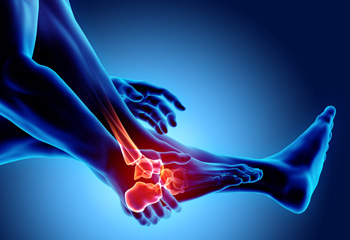 There are many people who enjoy sporting activities which may involve some type of running or jogging, and may be familiar with the pain and agony that often accompanies foot and ankle injuries. These may include the uncomfortable conditions that are known as plantar fasciitis, ankle fractures or sprains, and Achilles tendonitis. The importance of properly stretching the muscles before embarking on the chosen sport is crucial in helping to avoid painful trauma to the feet and ankles. These techniques may include a gradual increase in time spent pursuing these activities, which may aid in strengthening muscles and improving mobility. Research has suggested that proper running shoes should be replaced approximately every six months, and this will enable the feet to have proper cushioning. If you are experiencing pain or have endured an injury to the feet or ankles, it is suggested to seek the counsel of a podiatrist who can offer proper treatment advice.
There are many people who enjoy sporting activities which may involve some type of running or jogging, and may be familiar with the pain and agony that often accompanies foot and ankle injuries. These may include the uncomfortable conditions that are known as plantar fasciitis, ankle fractures or sprains, and Achilles tendonitis. The importance of properly stretching the muscles before embarking on the chosen sport is crucial in helping to avoid painful trauma to the feet and ankles. These techniques may include a gradual increase in time spent pursuing these activities, which may aid in strengthening muscles and improving mobility. Research has suggested that proper running shoes should be replaced approximately every six months, and this will enable the feet to have proper cushioning. If you are experiencing pain or have endured an injury to the feet or ankles, it is suggested to seek the counsel of a podiatrist who can offer proper treatment advice.
Foot and ankle trauma is common among athletes and the elderly. If you have concerns that you may have experienced trauma to the foot and ankle, consult with one of our podiatrists from Lovely Foot Associates, PC. Our doctors will assess your condition and provide you with quality foot and ankle treatment.
Foot and ankle trauma cover a range of injuries all over the foot; common injuries include:
Symptoms
Symptoms of foot and ankle injuries vary depending on the injury, but more common ones include:
Diagnosis
To properly diagnose the exact type of injury, podiatrists will conduct a number of different tests. Some of these include sensation and visual tests, X-rays, and MRIs. Medical and family histories will also be taken into account.
Treatment
Once the injury has been diagnosed, the podiatrist can than offer the best treatment options for you. In less severe cases, rest and keeping pressure off the foot may be all that’s necessary. Orthotics, such as a specially made shoes, or immobilization devices, like splints or casts, may be deemed necessary. Finally, if the injury is severe enough, surgery may be necessary.
If you have any questions, please feel free to contact our office located in Johnstown, PA . We offer the newest diagnostic and treatment technologies for all your foot care needs.
Read more about Foot and Ankle Trauma Ingrown toenails are very common but do have the ability to cause extreme discomfort. If the corners of a toenail begin to grow downward and inward while digging into the skin, then an ingrown toenail is forming. Ingrown toenails cause redness, discomfort, and swelling. Footwear is one of the root causes of ingrown toenails. Tight-fitting or high-heeled shoes can cause the big toe to become compacted, which can easily result in an ingrown toenail. Sports that put repetitive force on the toe can lead to the nail growing incorrectly, therefore proper footwear when participating in sports is essential to minimizing the risk of ingrown toenails. While certain footwear can result in ingrown toenails, the best way to avoid this affliction is to regularly clip your toenails. Toenails should be clipped directly across, so that the edges are less likely to dig into the skin. It is suggested to speak with a podiatrist if you feel that you may have an ingrown toenail and need treatment.
Ingrown toenails are very common but do have the ability to cause extreme discomfort. If the corners of a toenail begin to grow downward and inward while digging into the skin, then an ingrown toenail is forming. Ingrown toenails cause redness, discomfort, and swelling. Footwear is one of the root causes of ingrown toenails. Tight-fitting or high-heeled shoes can cause the big toe to become compacted, which can easily result in an ingrown toenail. Sports that put repetitive force on the toe can lead to the nail growing incorrectly, therefore proper footwear when participating in sports is essential to minimizing the risk of ingrown toenails. While certain footwear can result in ingrown toenails, the best way to avoid this affliction is to regularly clip your toenails. Toenails should be clipped directly across, so that the edges are less likely to dig into the skin. It is suggested to speak with a podiatrist if you feel that you may have an ingrown toenail and need treatment.
Ingrown toenails can become painful if they are not treated properly. For more information about ingrown toenails, contact one of our podiatrists of Lovely Foot Associates, PC. Our doctors can provide the care you need to keep you pain-free and on your feet.
Ingrown Toenails
Ingrown toenails occur when a toenail grows sideways into the bed of the nail, causing pain, swelling, and possibly infection.
Causes
Prevention
Because ingrown toenails are not something found outside of shoe-wearing cultures, going barefoot as often as possible will decrease the likeliness of developing ingrown toenails. Wearing proper fitting shoes and using proper cutting techniques will also help decrease your risk of developing ingrown toenails.
Treatment
Ingrown toenails are a very treatable foot condition. In minor cases, soaking the affected area in salt or antibacterial soaps will not only help with the ingrown nail itself, but also help prevent any infections from occurring. In more severe cases, surgery is an option. In either case, speaking to your podiatrist about this condition will help you get a better understanding of specific treatment options that are right for you.
If you have any questions please feel free to contact our office located in Johnstown, PA . We offer the newest diagnostic and treatment technologies for all your foot and ankle needs.
 Research has shown treatments for ankle sprains may differ depending on how severe the sprain is. Mild relief may be found in resting and elevating the foot, in addition to protecting the injured area for the first several days. If the foot is wrapped in a supportive bandage, swelling may decrease. As the resting period ends, it may be beneficial to perform exercises that may help to strengthen the ankle. This may aid in regaining stability and balance that is necessary to accomplish daily activities. There are several ankle stretches that may enhance range of motion and flexibility. These may include tracing letters of the alphabet with your toes and standing on one leg for several seconds. Both of these movements may help to improve strength and ankle movement. If you have sprained your ankle, it is suggested to seek the counsel of a podiatrist who can properly treat this condition.
Research has shown treatments for ankle sprains may differ depending on how severe the sprain is. Mild relief may be found in resting and elevating the foot, in addition to protecting the injured area for the first several days. If the foot is wrapped in a supportive bandage, swelling may decrease. As the resting period ends, it may be beneficial to perform exercises that may help to strengthen the ankle. This may aid in regaining stability and balance that is necessary to accomplish daily activities. There are several ankle stretches that may enhance range of motion and flexibility. These may include tracing letters of the alphabet with your toes and standing on one leg for several seconds. Both of these movements may help to improve strength and ankle movement. If you have sprained your ankle, it is suggested to seek the counsel of a podiatrist who can properly treat this condition.
Ankle sprains are common but need immediate attention. If you need your feet checked, contact one of our podiatrists from Lovely Foot Associates, PC. Our doctors can provide the care you need to keep you pain-free and on your feet.
How Does an Ankle Sprain Occur?
Ankle sprains take place when the ligaments in your ankle are torn or stretched beyond their limits. There are multiple ways that the ankle can become injured, including twisting or rolling over onto your ankle, putting undue stress on it, or causing trauma to the ankle itself.
What Are the Symptoms?
Preventing a Sprain
Treatment of a Sprain
Treatment of a sprain depends on the severity. Many times, people are told to rest and remain off their feet completely, while others are given an air cast. If the sprain is very severe, surgery may be required.
If you have suffered an ankle sprain previously, you may want to consider additional support such as a brace and regular exercises to strengthen the ankle.
If you have any questions please feel free to contact our office located in Johnstown, PA . We offer the newest diagnostic and treatment technologies for all your foot and ankle needs.